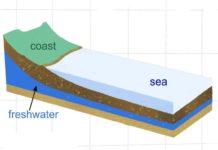
New research from The University of Texas at Arlington demonstrates that groundwater quality changes alongside the expansion of horizontal drilling and hydraulic fracturing but also suggests that some potentially hazardous effects may dissipate over time.
The new research, published today in the journal Science of the Total Environment in the article “Temporal Variation in Groundwater Quality in the Permian Basin of Texas, a Region of Increasing Unconventional Oil and Gas Development,” is the first to analyze groundwater quality in the Cline Shale region of West Texas before, during and after the expansion of hydraulic fracturing and horizontal drilling.
The research team collected and analyzed private water well samples on the eastern shelf of the Permian Basin four times over 13 months to monitor basic water quality, metal ions, organic ions and other chemicals. They discovered the presence of chlorinated solvents, alcohols and aromatic compounds exclusively after multiple unconventional oil wells had been activated within five kilometers of the sampling sites. Large fluctuations in pH and total organic carbon levels also were detected in addition to a gradual accumulation of bromide.
“These changes and levels are abnormal for typical groundwater quality,” said Kevin Schug, lead author of the study and UTA’s Shimadzu Distinguished Professor of Analytical Chemistry and director of the University’s Collaborative Laboratories for Environmental Analysis and Remediation, or CLEAR lab.
“The results also suggest that contamination from unconventional drilling may be variable and sporadic, not systematic, and that some of the toxic compounds associated with areas of high unconventional drilling may degrade or become diluted within the aquifer over time,” Schug said. “The next step is more research to precisely quantify and understand contamination cycles as well as to understand aquifer resilience to pollutants.”
The results also indicated that contamination pathways are complex. Various toxic compounds were detected in groundwater seemingly at random times in areas of high drilling activity.
“A collaborative effort with an oil and gas industry leader would better help us trace these occurrences, as well as focus on understanding the fate of specific recipes of proprietary chemicals,” Schug added.
Morteza Khaledi, dean of UTA’s College of Science, said the research enhances understanding of the potential impact drilling can have on groundwater while showing that those effects can diminish over time. The work supports UTA’s focus on research with global environmental impact, one of the four core themes of the University’s Strategic Plan 2020: Bold Solutions | Global Impact.”
“Clarifying misconceptions about the environmental effects of these new drilling technologies is vital to us all,” Khaledi said. “CLEAR and Dr. Schug have a particularly strong history of research in this area.”
The new paper, developed in collaboration with the University of North Texas, Baylor University and sampling firm Inform Environmental LLC, comes on the heels of two other recent studies, “A Comprehensive Analysis of Groundwater Quality in the Barnett Shale Region” published in Environmental Science & Technology in 2015, and “Elucidating Hydraulic Fracturing Impacts on Groundwater Quality using a Regional Geospatial Statistical Modeling Approach” in Science of the Total Environment, in 2016. Both studies discussed the detection of unconventional drilling-related abnormalities in the groundwater overlying the Barnett Shale in the Fort Worth Basin.
UTA’s CLEAR laboratories previously discovered beryllium concentrations in groundwater that could be associated with contamination from hydraulically fractured gas wells by way of structural failures in protective well casing. They also found elevated levels of 10 different metals as well as the presence of 19 different chemicals compounds including so-called BTEX (benzene, toluene, ethyl benzene and xylenes) compounds associated with hydraulic fracturing, as well as elevated levels of methanol and ethanol.
As early as 2013, an initial study of 100 private water wells in and near the Barnett Shale showed elevated levels of potential contaminants such as arsenic and selenium closest to natural gas extraction sites.
“CLEAR is running multiple research projects aimed to help the scientific community, the industry, and most importantly, the public, understand the potential effects of unconventional oil and gas development on the environment,” Schug said. “We are dealing with complex processes in complex and variable environments. It is our goal to develop and apply methods that provide reliable information about a wide variety of chemical constituents.”
Schug said it also is important to consider what can be done once a problem is found. CLEAR is dedicated to the development of remediation technologies and best management practices to effectively handle and decrease the occurrence of contamination events. Means for remediating contaminated water and soil are currently being tested in the laboratory and in field applications.
Note: The above post is reprinted from materials provided by University of Texas at Arlington.










